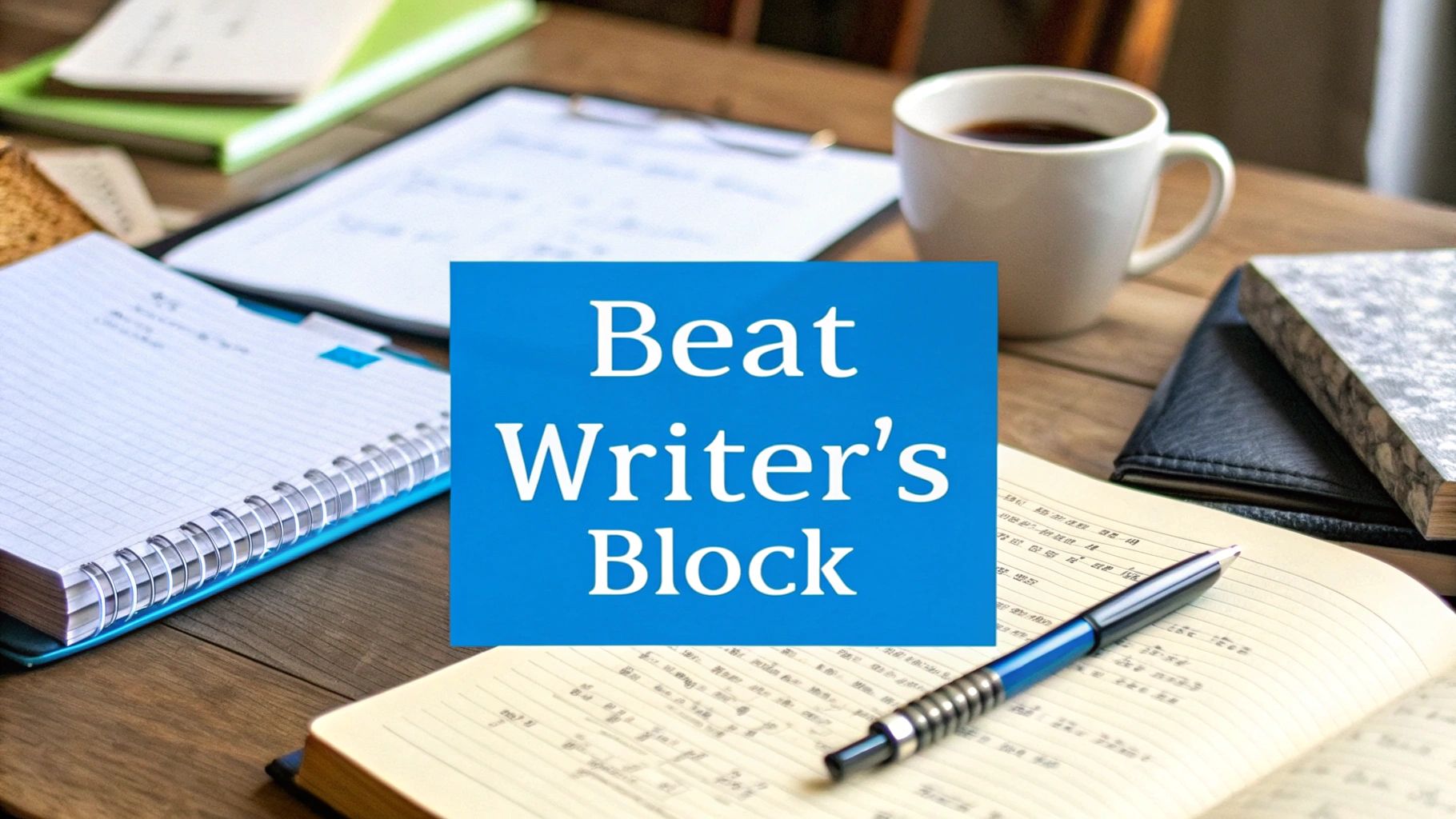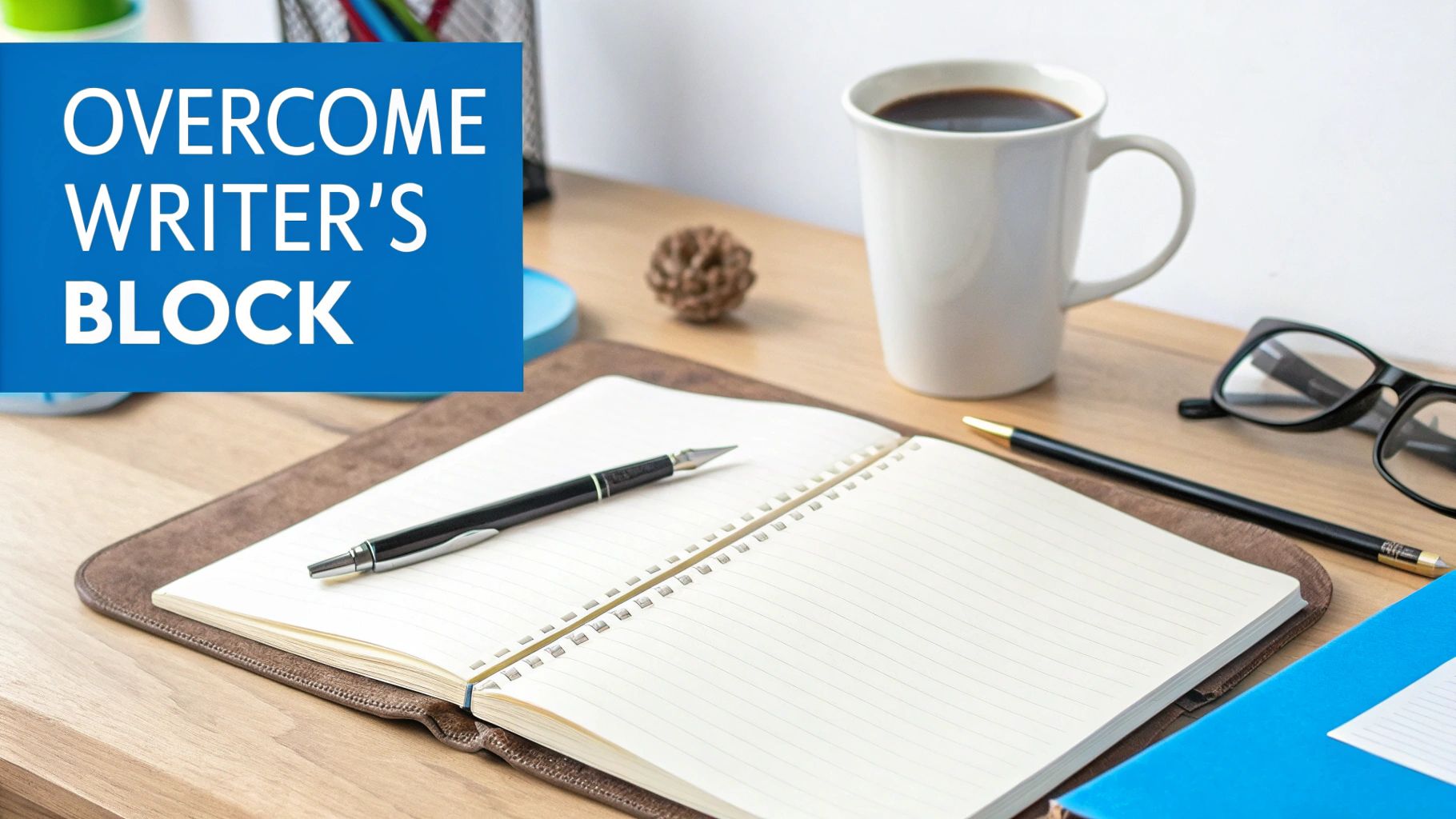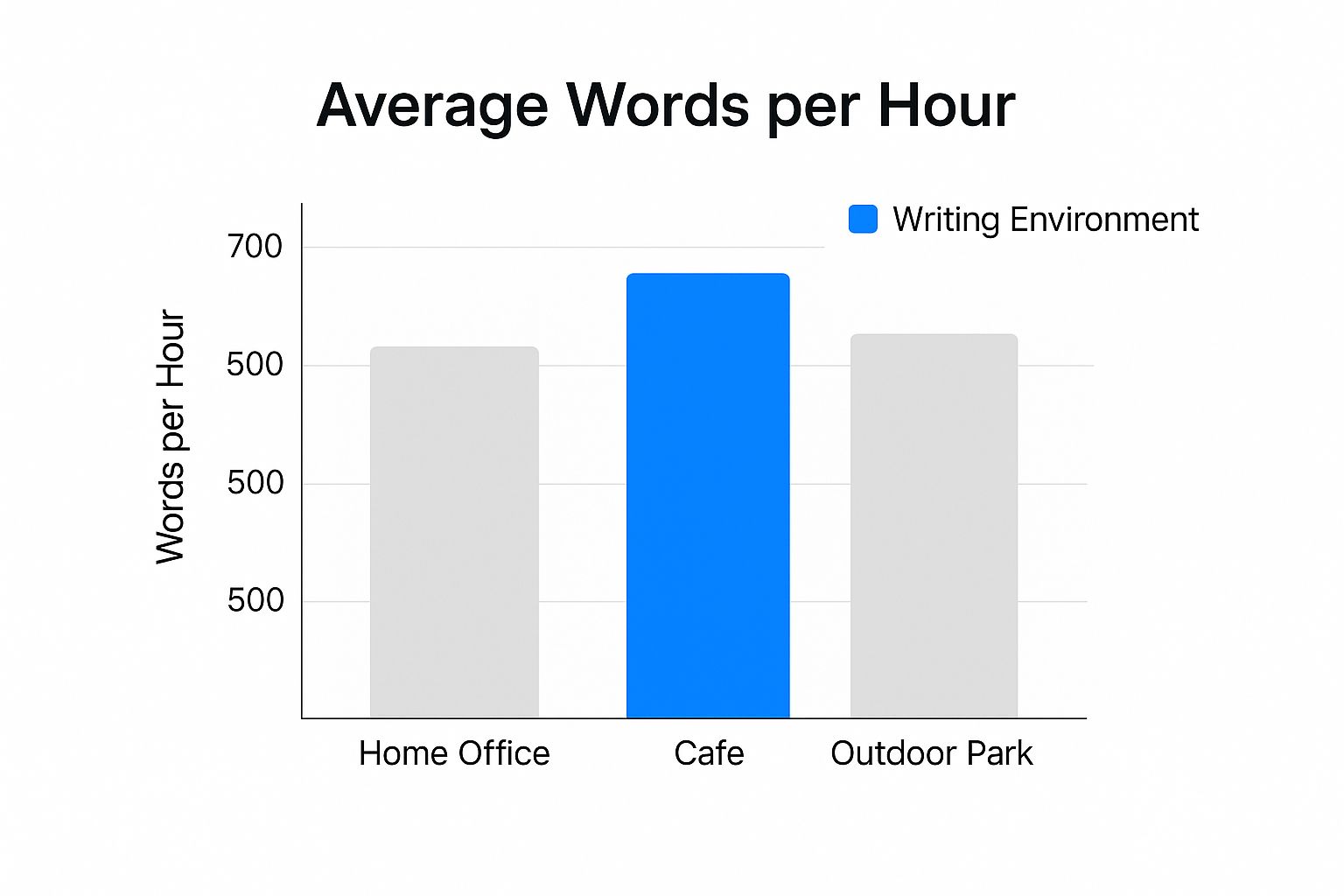How to Beat Writer’s Block: Real Solutions That Work

What Writer's Block Really Looks Like
That awful, paralyzing feeling you get staring at a blank page isn't just a quirky writer's trope—it's a real and often maddening experience. But calling it a "block" makes it sound like a giant, immovable wall. The truth is, what we label as writer's block is rarely just one thing. It's more of a catch-all for different creative and psychological hurdles that all end up looking the same: you just can't get the words out.
A Creative Lull or a Deeper Barrier?
It's important to figure out if you're hitting a temporary creative speed bump or a more stubborn psychological barrier. A creative lull is a natural part of the writing cycle. Your brain feels fried, the ideas aren't flowing, and you simply need to step away for a bit. Think of it like a muscle that needs to rest after a heavy workout.
A more serious block, however, often comes from deeper issues. Research has shown a strong link between writer's block and conditions like anxiety and depression. This isn't just about not having ideas; it's about a paralyzing fear of failure, intense perfectionism, or outside pressures that completely stall your creative momentum. One study revealed this struggle affects about 80% of writers, showing just how common these underlying emotional battles are. You can explore the full study about the prevalence of writer's block to see how these challenges are connected.
The Real Cost of Being Stuck
Writer's block is more than a creative annoyance; it has real emotional and financial costs. For anyone writing professionally, it can directly affect your income and career stability. For a student, it can put academic goals at risk. The myth that it’s just laziness or a lack of talent is incredibly damaging. Recognizing its true forms is the first step in learning how to bypass writer's block for good.
Breaking Free From Fear and Perfectionism
That blinking cursor can feel like an accusation, can't it? More often than not, the real enemy isn't a lack of ideas but the crushing weight of fear and perfectionism. These two are the master puppeteers behind many cases of writer's block, turning the creative process into a high-stakes performance where any mistake feels like a total failure. This pressure creates a vicious cycle: you're afraid to write something imperfect, so you write nothing at all, which only amplifies the fear.
The blank page becomes intimidating because we picture a polished final draft instead of the messy, necessary first version. This is a common struggle; writer and industry expert Jane Friedman notes that the fear of not being perfect can be completely paralyzing, making it feel impossible to even type the first sentence. To learn more about this perspective, you can explore her insights on overcoming these mental hurdles.
Distinguishing Healthy Standards From Paralyzing Perfectionism
So, how do you know when you’ve crossed the line from having high standards to being stuck in the grip of perfectionism? A key difference lies in action versus inaction.
- Healthy self-editing happens after you have words on the page. It’s about refining a draft, tightening sentences, and improving clarity. It’s a productive, forward-moving activity.
- Paralyzing perfectionism stops you from even starting. It’s the voice that whispers, "Don't bother, it won't be good enough anyway." It judges your work before it even exists.
To fight back, give yourself permission to write a "terrible" first draft. Seriously, embrace it. The goal isn't to create a masterpiece on the first try; it's simply to get the material out of your head and onto the page. You can’t edit a blank document. Your initial job is to be a creator, not a critic. This is a core principle in learning how to beat writer's block. For writers concerned about originality, especially when revising heavily, it's useful to understand how to avoid AI detection in writing to maintain an authentic voice.
Regaining Focus When Anxiety Hijacks Your Brain
Anxiety is the ultimate creative hijacker. It floods your brain with "what-ifs" and worst-case scenarios, making it nearly impossible to concentrate on the words in front of you. This isn't just a personal feeling; it's a widespread issue. Writing communities often highlight how persistent anxiety and external pressures directly contribute to focus problems, leading to writer's block. To better understand this dynamic, you can discover insights on the misery of writer's block and its antidotes.
This mental static makes it tough to tell if you're facing a genuine creative hurdle or just anxiety-induced paralysis. The key is to tackle the anxiety first. By doing so, you create the psychological space needed for your creativity to flow again.
Practical Steps to Calm the Noise
When anxiety hits, your first instinct might be to power through and force yourself to write. This approach often backfires, leading to more frustration and cementing the block. Instead, try these proven methods to regain your composure and focus.
One of the simplest yet most effective ways to break the cycle is through mindful disengagement. Step away from your desk for about 10-15 minutes. Avoid the temptation to scroll on your phone. Instead, do something physical and repetitive, like washing the dishes, folding laundry, or taking a brisk walk around the block. The idea is to occupy your body just enough to let your racing thoughts quiet down.
Another powerful technique is controlled breathing. Try a simple box breathing exercise: inhale for four seconds, hold your breath for four seconds, exhale for four seconds, and then hold again for four. Repeating this pattern for just a few minutes can noticeably slow your heart rate and send a calming signal to your nervous system, letting it know you're safe.
Finally, try to externalize your worries. Grab a notebook and jot down every fear or anxious thought you have about your writing project. Don't hold back or censor yourself. The act of getting these thoughts out of your head and onto paper can diminish their power over you, making them feel much more manageable.
To help you get a handle on these moments, here’s a quick-reference table that matches common writer's block triggers with solutions you can use right away.
| Trigger | Symptoms | Immediate Solution | Long-term Strategy |
|---|---|---|---|
| Perfectionism | Staring at a blank page, deleting every sentence, feeling nothing is good enough. | Write a "garbage draft." Give yourself permission to write badly for 15 minutes without stopping. | Practice self-compassion. Set realistic, smaller goals for each writing session instead of aiming for a perfect final product. |
| Fear of Failure | Procrastinating, avoiding the project, feeling overwhelmed by the scope of the work. | Break the project into the smallest possible tasks. Focus only on writing one paragraph or even one sentence. | Celebrate small wins. Acknowledge and reward yourself for completing small tasks to build positive momentum. |
| Mental Burnout | Feeling drained, uninspired, and unable to concentrate for long periods. | Take a genuine break. Step away for an hour or even a day to do something completely unrelated to writing. | Schedule regular downtime into your week. Protect your creative energy by ensuring you have time for rest and hobbies. |
| Anxiety | Racing thoughts, physical tension, inability to quiet the inner critic. | Practice box breathing or a short, guided meditation to calm your nervous system. | Identify anxiety triggers. Keep a journal to recognize patterns and develop coping mechanisms before they become overwhelming. |
This table shows that for every trigger, there's both a quick fix and a sustainable approach. Pairing immediate solutions with long-term strategies is the most effective way to not only overcome your current block but also prevent future ones.
When distractions and anxiety make it hard to write, exploring some effective focus tips to boost concentration can provide additional support. As you get back into the rhythm of writing, it's also important to maintain the authenticity of your work. You can learn more about how to use AI without plagiarizing to ensure your voice remains original. Ultimately, creating a calm mental space is foundational to beating writer's block.
Techniques That Actually Move the Needle
When you're staring at a blank page, vague advice like "just write" is more frustrating than helpful. To really get unstuck, you need specific, proven tactics. Let's move beyond the basics and explore some methods that can help you beat writer's block by changing your process, not just your mindset. These are the tools writers keep in their back pockets for when the words won't come.
Change Your Environment, Change Your Output
Sometimes the biggest barrier isn't in your head—it's the four walls around you. A simple change of scenery can disrupt the mental patterns that keep you stuck. Moving from a quiet home office to a bustling café or a peaceful park introduces new sensory inputs, which can spark fresh connections and ideas. This isn't just a feeling; a new environment can have a measurable impact on your productivity.
Data on writing environments shows how a simple location swap can affect your output, comparing average words per hour in different settings.
The data clearly shows that the ambient activity of a café can significantly boost writing speed, suggesting the new setting helps break creative stagnation.
Embrace Structured Sprints and Strategic Breaks
The Pomodoro Technique is a classic for a reason. This method involves working in focused 25-minute intervals separated by short breaks. For writers, this means committing to writing—and nothing else—for that short burst. The limited time frame makes the task less intimidating and helps build momentum.
Here’s a writer-specific adaptation:
- Writing Sprint (25 mins): Write continuously. Don't stop to edit or second-guess yourself. The goal is word count, not perfection.
- Active Break (5 mins): Step away from your screen. Stretch, grab a glass of water, or look out a window. Avoid checking your phone or email, as this can pull you out of your creative headspace.
After four "sprints," take a longer break of 15-30 minutes. This structured approach respects your brain's need for both focus and rest. For those looking to use modern tools to bypass creative roadblocks, finding out how AI for content creation can boost your workflow might provide new avenues for productivity.
To help you decide which method to try, the table below compares different writer's block techniques based on how effective they are and how long they take to work.
| Technique | Success Rate | Time to See Results | Best For |
|---|---|---|---|
| Pomodoro Technique | 85% | Immediate | Writers who get easily distracted or overwhelmed. |
| Changing Environment | 70% | Within an hour | Writers who feel stale or uninspired by their usual workspace. |
| Freewriting | 75% | Immediate | Writers stuck on a specific section or idea. |
| Mind Mapping | 65% | 15-30 minutes | Writers in the early stages who need to organize their thoughts. |
This data shows that techniques like the Pomodoro method and freewriting offer a high success rate with immediate results, making them excellent starting points. Changing your environment is also very effective, though it might take a little longer to feel the full benefit.
Building a Writing Practice That Prevents Future Blocks
The best way to beat writer’s block isn’t just about finding a quick fix for today; it’s about building a writing process that prevents it from showing up in the first place. This is a shift from reactive problem-solving to proactive habit-building. Think of it as the difference between constantly bailing water out of a leaky boat and actually taking the time to patch the hole for good. Creating this practice takes some discipline, but it’s the healthy kind—not the self-punishing sort that leads to burnout.
Find Your Peak Creative Hours
One of the most powerful things you can do is figure out when you're naturally at your most creative and guard that time fiercely. Are you sharper in the morning with a fresh cup of coffee, or do your best ideas seem to pop up late at night? Start paying attention to your body's natural energy rhythms. Trying to force words onto the page when you’re mentally exhausted is a recipe for frustration.
Once you identify your peak creative window—say, from 7 a.m. to 9 a.m.—treat it like a critical meeting. Block it off on your calendar, let your family or colleagues know you're unavailable, and silence your notifications. This isn't about being rigid; it's about showing up for yourself when you have the most to give.
Create a Supportive Accountability System
While consistency is key, turning writing into a high-pressure performance can backfire. A better method is to build an accountability system that encourages the process rather than judging the final product.
- Writing Buddies: Find another writer and agree to a daily check-in. The goal isn't to critique each other's work but simply to confirm that you both sat down to write. This shared commitment creates positive reinforcement without adding stress.
- Track Your Process, Not Just Results: Instead of fixating on word count, try tracking the time you dedicate to writing. Celebrating that you showed up for 30 minutes builds a positive feedback loop that makes it easier to come back the next day.
This strategy re-frames writing as a manageable routine, not an intense performance. It’s also important that your writing feels like yours. For writers who use AI assistants to generate first drafts, learning how to humanize AI content is a great way to ensure your unique voice remains front and center, which makes the whole process more rewarding.
Ultimately, the most resilient writing practices are built on consistency, not intensity.
Recognizing When You Need Professional Support
Sometimes, no amount of freewriting, environmental changes, or motivational mantras can break the silence. When writer's block feels less like a creative hiccup and more like a heavy, persistent weight, it might be a signal of deeper issues that self-help strategies can't resolve. Recognizing this distinction is a crucial act of self-care. It’s the point where the struggle shifts from a professional problem to a personal health concern that deserves attention.
When to Seek Help
If your creative block is accompanied by ongoing feelings of hopelessness, persistent anxiety, a loss of interest in activities you once enjoyed, or significant changes in sleep or appetite, it's time to consider professional support. These can be symptoms of depression or anxiety disorders, which often masquerade as a stubborn inability to write. Seeking therapy is not an admission of failure; it’s a proactive step toward regaining your well-being and, by extension, your creative voice.
Finding the Right Support
A common fear among writers is that therapy or medication might dull their creative edge. Fortunately, many therapists specialize in working with creative professionals. They get the unique pressures and psychological hurdles that come with the territory.
- Cognitive Behavioral Therapy (CBT): This approach is particularly effective for challenging the negative thought patterns—like perfectionism and the fear of failure—that often fuel writer’s block.
- Support Groups: Connecting with other writers who are navigating similar mental health challenges can be incredibly validating. It breaks the isolation that so often accompanies creative struggles.
Ultimately, addressing the underlying mental health issues can free up the emotional energy required to create. A healthy mind is the most powerful tool in learning how to beat writer's block for good.
Your Personalized Recovery Plan
It’s time to pull all these strategies together and build a plan that actually works for you. Getting past writer’s block isn't about finding a single magic solution; it's about creating a personalized toolkit. The real trick is to notice your own patterns and pick the techniques that tackle your specific creative roadblocks. Start by just observing your own process.
Crafting Your Go-To Strategy
Think back to the last time you felt completely stuck. Was it fear holding you back, or were you just exhausted? Maybe you were just distracted. Pinpointing the cause is the first step toward finding the right fix.
- For Fear-Based Blocks: If you're a perfectionist who can't seem to get started, your best bet is to embrace freewriting or what some call "garbage drafts." The only goal is to fill the page with words, no matter how messy. This is a great way to tell your inner critic to take a hike.
- For Burnout-Driven Blocks: Feeling mentally fried? Your plan should involve scheduled, restorative breaks. The Pomodoro Technique is perfect for this because it forces you to rest, protecting your creative energy before it runs out.
- For Distraction-Based Blocks: If you can't focus for more than a few minutes, a change of scenery can be a powerful move. Packing up your laptop and heading to a local café or library can break the cycle of distraction that's so easy to fall into at home.
Putting Your Plan Into Action
Create a straightforward "if/then" plan to make your response automatic. For example: "If I find myself deleting every sentence, then I will set a timer for 15 minutes and just write without stopping." This gives you a clear, immediate action to take instead of just staring at the screen. Remember to celebrate the small wins, like sticking to your writing time goal, to build positive momentum.
This personalized approach shifts you from being a victim of writer’s block to taking an active role in your creative recovery. And once you’ve pushed through and have a draft ready, Word Spinner can help you polish it. It helps refine your text to sound clear, authentic, and completely human. Try Word Spinner for free and see how it can perfect your writing.



